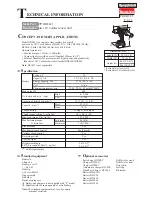
GSC3218WA
Owner’s Manual
17
Sudden drop in gas flow or
reduced flame height.
Tank out of gas.
Check for gas in propane tank.
Irregular flame pattern, flame does
not run the full length of burner.
Flame is yellow or orange.
Excess flow safety device may
have been activated.
Burner ports are clogged or
blocked.
New burner may have residual
manufacturing oils.
Spider webs or insect nest in
venturi.
Food residue, grease or
seasoning salt on burner.
Poor alignment of valve to burner
venturi.
Refer to the
Excessive flow safety valve
reset procedure
on page 15.
Clean burner ports.
Burn grill for 15 minutes with the lid closed.
Clean venturi.
Clean burner.
Assure burner venturi is properly engaged
with valve.
Flame blow out.
High or gusting winds.
Turn front of grill to face wind or
increase flame height.
Low on propane gas.
Replace or refill propane tank.
Excess flow valve tripped.
Refer to the
Excessive flow safety
valve reset procedure
on page 15.
Flare-up.
Grease buildup.
Clean grill.
Excessive fat in meat.
Trim fat from meat before grilling
.
Excessive cooking temperature.
Adjust (lower) temperature
accordingly.
Persistent grease fire.
Grease trapped by food buildup
around burner system.
Flashback [fire in burner tubes].
Burner and /or burner tubes are
locked
.
Turn knobs to OFF. Turn gas OFF at
propane tank. Leave lid in closed
position and let fire burn out. After grill
cools, remove and clean all parts.
Clean burner and/or burner tube(s).
Inside of lid is peeling – like paint
peeling.
The lid is stainless steel, not
painted.
Baked on grease buildup has turned to
carbon and is flaking off. Clean
thoroughly.
Irregular flame.
Air flow is not correct. Correct
Flame blue with yellow tips, 1-2”
high. Too little air: wavy yellow or
orange flames. Too much air:
noisy blue flames.
If flames are yellow or orange – open flap
at the end of the venturi tubes in
1/8” increments until flames are
correct.
If flames are blue and noisy – close flap at
the end of the venturi tubes in
1/8” increments until flames are
correct.
*Propane Models must be open a
minimum of 1/8”
*Natural Gas Models must be open a
minimum of 1/16”


































